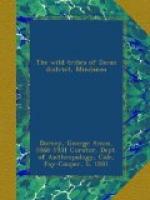The patterns brought out in the weaving are as beautiful and intricate as they are confusing. Five typical specimens of cloth used in women’s skirts are shown in Plate XXXVII. In them can be found several apparently different designs to some of which names were assigned, but as there was no agreement among my informers I refrain from giving them here. The pattern marked X in (c) was generally identified as “alligator,” yet the weavers were by no means agreed.
The strip of cloth (Plate XXXVIII) was intended for the center breadth in a woman’s skirt and shows the typical designs employed in the best garments.
The extensive use of beads is shown in Plates XXXIX-XL. Carrying bags, clothing, combs, necklaces, armlets, belts and sheath covers are partially covered with or made up of colored beads, always in designs, yet very few of these patterns have generally accepted meanings or names. The same holds true of the designs in shell disks, which, on the finer garments, take the place of beads. A few exceptions to this are found in which realistic patterns appear in (Plate XXXIb and Fig. 34).
FIG. 34. REALISTIC PATTERNS IN BEADS AND SHELL DISKS.
Like the bead work, the embroidery and applique found on many garments are added “to make pretty.” Some of this work is quite fine, but in general that of recent years is either inferior to that found on old garments or is borrowed from, or made by, the Bila-an women. Some garments, with designs produced by oversewing before dyeing, are seen here, but they are recent importations from the Kulaman or Tagakaolo tribes.
Necklaces and leglets are made of rattan and are decorated with burned lines or by being overlaid with platted strips of orchid and fern cuticle (Fig. 2).
A few rare specimens, such as personal ornaments or basket rims, have sewed in designs in which the sewing has been done with fern cuticle (Plate XXXIVb).
Incised patterns appear on nearly all the bamboo lime and tobacco holders, but here individual fancy plays such an important part that a hundred specimens might be examined without finding duplicate patterns. Fig. 14. shows nine of these tubes covered with cut-in designs, yet only one figure, that marked X in b could be identified. This was said to be the familiar crocodile.
Coming to the work in brass and copper we encounter an entirely new type of design. In some cases straight inlaid or overlaid strips and twisted wires are used to ornament the specimen; while in the raised and cut-in lines on the bells we find simple patterns. In the main, however, the ornamentation on this class of material consists of complicated scrolls (Plate XLI), designs suggesting flower or tree patterns, or conventionalized figures. One only needs to compare these objects with similar specimens from Borneo and the Malayan Islands of the South, to find the source of this type of ornamentation.[1] In fact the imitation




